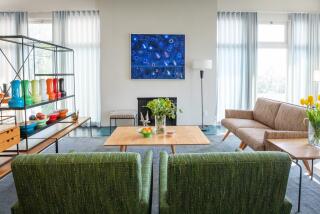DESIGN : Light Fixtures of Copper and Oak Are Shining Examples of Arts and Crafts
- Share via
There is a resurgence of interest in the straightforward furniture of the Arts and Crafts movement, but collectors who want to re-create this turn-of-the-century style in their homes face a dilemma--finding appropriate lighting.
Lighting in the Arts and Crafts era was produced by factories in a wide range of lighting styles, including Arts and Crafts, and by individual craftspeople who specialized in high-quality, handcrafted lamps and lighting fixtures.
Perhaps the best-known craftsman was Dirk van Erp (1860-1933), a metalsmith who emigrated from the Netherlands in 1886 and settled in San Francisco. By 1910 he had developed a reputation as a skilled coppersmith and lighting designer. His unique lamps, from 12 to 24 inches high, featured hand-hammered copper bases and mica shades.
By treating copper with various chemicals, van Erp produced a reddish-brown patina that was complemented by the orangish hue of the mica. The result was a warm glow that provided light while virtually eliminating the harsh glare of the electric bulb.
Van Erp’s shopmark--the metalsmith’s name below the outline of a windmill--can command more than $50,000 today for the largest and rarest lamps, while smaller, more modest lamps go for $5,000 to $10,000.
Such furniture manufacturers as Gustav Stickley, Charles Limbert and Elbert Hubbard also offered lamps in the Arts and Crafts style, produced by skilled woodworkers and metalsmiths who created handcrafted lighting fixtures destined to last for centuries.
Most of the lighting fixtures from Stickley’s Craftsman Workshops were constructed either of hammered copper or quartersawn oak, with natural wicker shades lined with silk.
The greatest number of signed Arts and Crafts lighting fixtures were produced by Hubbard’s Roycroft Copper Shop in East Aurora, N.Y. Credit for the development of the Roycroft Copper Shop goes to Karl Kipp, who arrived in 1908 and demonstrated a natural ability to both design and craft a variety of copper items, from letter openers to massive chandeliers. The table lamps he designed and produced for Roycroft feature hand-hammered bases and shades.
When it became clear that the Arts and Crafts style was more than a passing fad, lighting manufacturers that had previously been producing Victorian, Colonial and other popular styles began incorporating Arts and Crafts designs into their inventories.
The majority of these lighting fixtures--table lamps, wall sconces and ceiling lights--were made of oak. Their shades generally were fitted with sheets of colored glass, making them far more affordable than the hammered-copper and mica lamps or the Tiffany-style stained-glass lamps. The most popular colors of glass were amber and green.
Demand for even the most basic Arts and Crafts table lamp, consisting of a square base, a single square post and a four-sided slag-glass shade, has driven prices from the $50-$100 range into the $150-$200 level. Lamps with additional detailing can quickly climb into the $250-$500 range.
The shortage today of affordable period light fixtures has encouraged a number of individual craftspeople and lighting manufacturers to produce Arts and Crafts-style lighting.
The quality, designs and prices of these fixtures vary tremendously.
They range from such coppersmiths as Michael Adams of Oswego, N.Y., and Michael Ashford, in Olympia, Wash., who painstakingly retrace van Erp’s work to produce hand-hammered copper-and-mica lamps, to lighting manufacturers who stamp out or import poorly made reproductions.
More to Read
The biggest entertainment stories
Get our big stories about Hollywood, film, television, music, arts, culture and more right in your inbox as soon as they publish.
You may occasionally receive promotional content from the Los Angeles Times.










